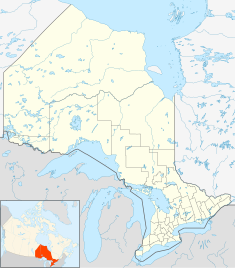| Buxton National Historic Site and Museum | |
|---|---|
 Bell at Buxton National Historic Site and Museum | |
| Location | North Buxton, Ontario, Canada |
| Coordinates | 42°18′20.4″N 82°13′13.5″W / 42.305667°N 82.220417°W |
| Area | 9,000 acres (36 km2) |
| Built | 1849 |
| Governing body | Parks Canada |
| Website | Buxton Museum Official Webpage |

The Buxton National Historic Site and Museum is a tribute to the Elgin Settlement (also known as the Buxton Mission, Raleigh, Kent County), established in 1849 by Reverend William King (1812–1895),[1]: 40 and an association which included Lord Elgin, then the Governor General of Canada. King, a former slave owner turned abolitionist, purchased 9,000 acres (36 km2) of crown land in Southwestern Ontario and created a haven for fugitive slaves and free Blacks.[1]: 41 It was also a terminus on the Underground Railroad from the United States.[2]
The Elgin settlement was divided into 50-acre (200,000 m2) lots which could only be purchased by Black settlers.[2].Black settlers had 10 years to pay for their property, and houses were built to minimum standards.[2] By 1864, there was a steam grist mill, steam saw-mill, shoe shop, two general stores, a blacksmith, cooperage, school with forty students on average, and a church (24 by 32 feet (7.3 m × 9.8 m)) seating 200.[1]: 40
The need for the mission was considered no longer and the Buxton Mission Fund was closed by 1865 when 'the liberty of the slaves was proclaimed' at the end of the American Civil War.[1]: 42–43
Opened in 1967, the museum complex includes the main building with exhibits about the community and its history, an 1861 schoolhouse, an 1854 log cabin, and a barn. Local historic church cemeteries are adjacent to the museum. The museum is located in North Buxton, Ontario, near South Buxton in Chatham-Kent. It was designated as a National Historic Site of Canada in 1999.[3]
- ^ a b c d SEXSMITH, W. N. (1919). Papers and addresses (Some notes on the Buxton Settlement, Raleigh, Kent County). Chatham, Ontario, Canada: Kent Historical Society.
- ^ a b c "Elgin Settlement". www.thecanadianencyclopedia.ca. Retrieved 2024-02-07.
- ^ Parks Canada Agency, Government of Canada (2022-02-01). "Buxton Settlement — National historic site designation - Buxton Settlement National Historic Site". parks.canada.ca. Retrieved 2024-02-07.
